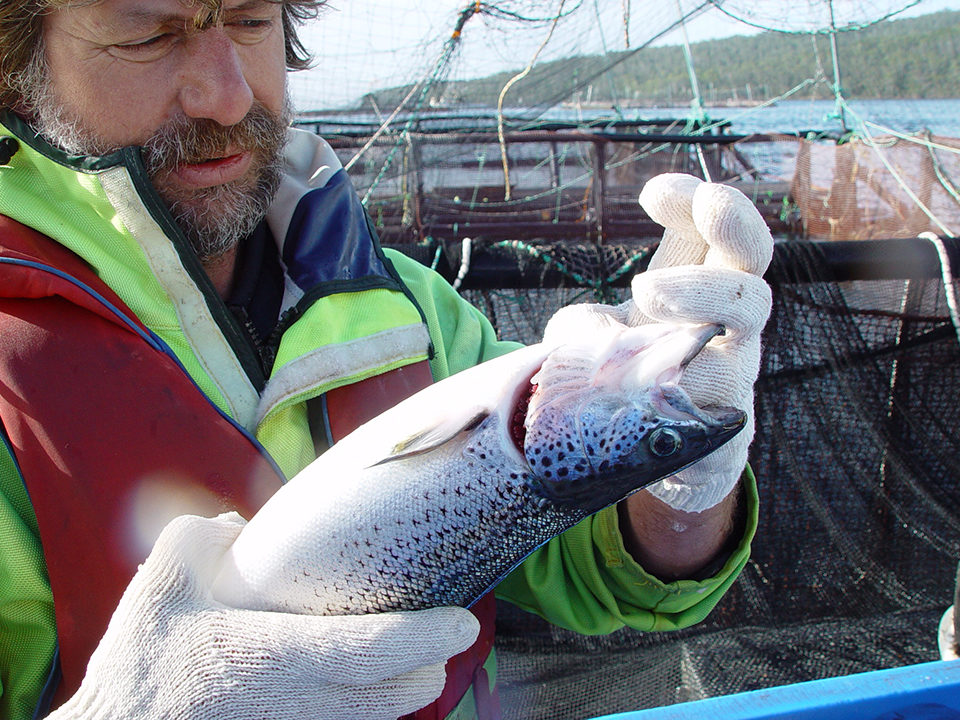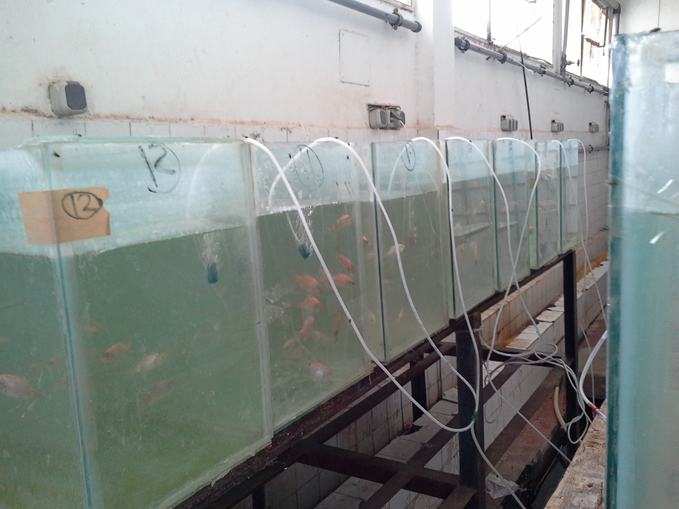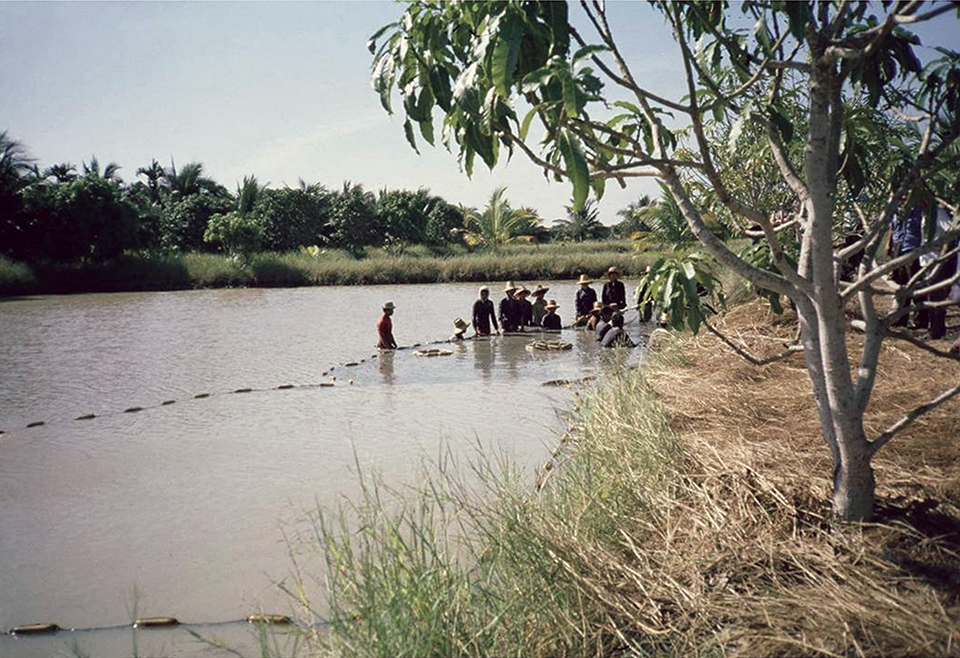Partnership using DNA genotyping to reduce AGD treatments

A unique selective-breeding program developed for Australia’s $330 million Tasmanian Atlantic salmon industry is predicted to result in ongoing reductions in production costs.
The breeding program for Salmo salar, which began in 2004, is unique in three ways. It operates in an all-female commercial production system, uses DNA pedigree assignment and has resistance to an external gill parasite as a primary breeding objective. In 2008, the program produced the first genetically selected families.
This Atlantic salmon selective-breeding program is the result of a six-year research partnership between the Food Futures Flagship of the Commonwealth Scientific and Industrial Research Organisation and Salmon Enterprises of Tasmania Pty. Ltd. (SALTAS). SALTAS is a cooperative venture that produces Atlantic salmon eggs and smolts for its Tasmanian industry shareholders.
Tailored to industry
The program’s primary aims are to decrease costs of production by improving growth rates and resistance to amoebic gill disease (AGD), a condition that adds significantly to the production cost of Tasmanian salmon. Secondary aims are to reduce incidence of early maturation and maintain carcass quality traits such as flesh color and fat content. The program is tailored to suit the industry’s operational systems, resources and production constraints.
Traditional aquaculture selective-breeding programs raise families in separate tanks until the individuals grow large enough to be tagged and mixed. The Tasmanian program avoids this costly practice by using DNA genotyping to provide pedigree information. This enables mixed family grow-out after hatching.
Freshwater, marine growout
The program revolves around a three-year production cycle with three cycles in operation at any time. Three age groups of fish are grown simultaneously, and about 150 salmon families containing a total of 5,000 to 7,000 pedigreed individuals are produced each year.
The salmon broodstock are maintained and spawned in freshwater, and the eggs are hatched and raised to 1-year-old smolt stage at the SALTAS freshwater hatchery at Wayatinah in Tasmania’s Central Highlands. The smolts are tagged and DNA fingerprinted, then split into two groups for either freshwater grow-out and broodstock conditioning or performance testing during a marine grow-out. The marine fish are transferred to purpose-built sea cages at a Tassal Group Ltd. marine farm south of Hobart, where they are raised for a further 14 months to harvest size.
The salmon are assessed for amoebic gill disease three to five times during the marine grow-out by inspecting the gills for lesions. The development of sexual maturation is measured in both the freshwater and marine groups. At about 4.5 kg, the marine group fish are harvested, weighed and assessed for carcass quality.
Performance analysis
The research partnership has developed systems for capturing, storing and processing hundreds of thousands of pedigree and performance measurements, as well as protocols and tools for tagging and genotyping. This includes the annual analysis of the performance of all individuals, including both current and previous year classes, to calculate “estimated breeding values” for the key performance traits.
The analysis uses the performance of individuals, their siblings, parents and more-distant relatives to determine which fish to breed for the next generation. An economic weighting given to each selection trait helps achieve the best overall outcome for growers.
Biosecurity issues require that individuals that go into marine grow-out do not return to the freshwater hatchery. Therefore, freshwater broodstock selection is based on the marine performance of relatives. Moderate genetic correlations have been observed between same-age freshwater and marine growth measures of total weight, so freshwater measures are also used for selection decisions.
Grounds for genetic gains
Atlantic salmon farming began in Tasmania in 1984 with foundation stocks descended from fish imported to New South Wales from the east coast of Canada in the 1960s. During the first 20 years of the industry, six generations of Tasmanian Atlantic salmon were bred to maintain genetic diversity.
DNA marker analyses and quantitative genetic analyses over seven years of family production have shown the imported population had sufficient genetic variation to allow good commercial gains from selective breeding. Moderate genetic variation has been found for all traits and across all year classes (Table 1) with values comparable to those reported for other Atlantic salmon populations.
Elliott, Genetic variation of commercial traits, Table 1
| Trait | Heritability |
|---|---|
| AGD resistance (gill score at first infection) | 0.17 ± 0.03 |
| AGD resistance (gill score at second to fifth infections) | 0.32 ± 0.04 |
| Marine weight | 0.39 ± 0.08 |
| Freshwater weight | 0.43 ± 0.09 |
| Early maturation incidence (marine) | 0.21 ± 0.04 |
| Early maturation incidence (freshwater) | 0.12 ± 0.04 |
| Flesh color (astaxanthin content) | 0.40 ± 0.12 |
| Flesh fat content (total fat content) | 0.47 ± 0.06 |
Atlantic salmon population as indicated by heritabilities in a combined analysis across year classes.
The selective-breeding program has produced seven year classes: 2004 to 2010. Genetic links between year classes allow management as a single genetic population. In 2004, 70 full-sib families were produced. Their DNA pedigrees – identified by Landcatch Natural Selection of Scotland – assigned 96 percent of a random sample of 4,350 individuals to a family, with family representation at 22 to 117 individuals.
Each following year, the program spawned 180 families. Pedigree assignment has improved, with 99 percent of 9,341 individuals in the 2007 year class allocated to single families.

Disease resistance
Major marine production costs for the Tasmanian industry not experienced to the same degree in other Atlantic salmon-producing countries include treatment and lost productivity due to AGD. The disease occurs when microscopic amoebas attach to salmon gills. Infected salmon are safe to eat, but lose condition, experience slower growth and die without treatment.
Management of AGD costs the industry in excess of $25 million a year in lost productivity and freshwater bathing, the only current effective treatment. A key research question was therefore whether there was genetic variation in resistance to this external gill parasite.
Results from five years of data showed that AGD resistance is a quantitative trait, with moderate genetic variation at all infections. Commercial fish can have six to 12 infections and subsequent freshwater treatments during their marine grow-out.
However, there is low genetic correlation between the first and subsequent infections, suggesting the first infection is a different genetic trait. Research results suggested there is potential to reduce the number of AGD treatments by 25 percent over approximately six years of selective breeding.
Commercial production
The rate of transfer of genetic gains into commercial returns is influenced by an all-female production system. The Tasmanian commercial harvest is 95 percent based on all-female production. This is due to a high incidence of early maturation and related poor condition prior to harvest, particularly in males in their first summer at sea.
All-female production requires the making of sex-reversed females or neo-males. Therefore, infusing genetic gains from the selective-breeding program into commercial production requires an additional step with a multiplier population to create the neo-males. The first commercial production from selected multiplier broodstock will be in 2011 with harvest in 2014.
(Editor’s Note: This article was originally published in the March/April 2011 print edition of the Global Aquaculture Advocate.)
Now that you've reached the end of the article ...
… please consider supporting GSA’s mission to advance responsible seafood practices through education, advocacy and third-party assurances. The Advocate aims to document the evolution of responsible seafood practices and share the expansive knowledge of our vast network of contributors.
By becoming a Global Seafood Alliance member, you’re ensuring that all of the pre-competitive work we do through member benefits, resources and events can continue. Individual membership costs just $50 a year.
Not a GSA member? Join us.
Authors
-
N.G. Elliott
CSIRO Food Futures Flagship
CSIRO Marine and Atmospheric Research
Hobart, Tasmania 7000 Australia[117,97,46,111,114,105,115,99,64,116,116,111,105,108,108,101,46,107,99,105,110]
-
H. King
CSIRO Food Futures Flagship
CSIRO Marine and Atmospheric Research
Hobart, Tasmania 7000 Australia -
P.D. Kube
CSIRO Food Futures Flagship
CSIRO Marine and Atmospheric Research
Hobart, Tasmania 7000 Australia -
R.S. Taylor
CSIRO Food Futures Flagship
CSIRO Marine and Atmospheric Research -
B. Evans
Salmon Enterprises of Tasmania Pty. Ltd.
Wayatinah, Tasmania, Australia
Tagged With
Related Posts

Health & Welfare
Applied commercial breeding program for Nile tilapia in Egypt
A major goal of selective breeding program for Nile tilapia (Oreochromis niloticus) in Egypt is to select for fillet color and fillet weight in response to consumer preferences.

Health & Welfare
‘Big picture’ connects shrimp disease, inbreeding
Disease problems on shrimp farms may be partly driven by an interaction between management practices that cause inbreeding in small hatcheries and the amplification by inbreeding of susceptibility to disease and environmental stresses.

Health & Welfare
10 paths to low productivity and profitability with tilapia in sub-Saharan Africa
Tilapia culture in sub-Saharan Africa suffers from low productivity and profitability. A comprehensive management approach is needed to address the root causes.

Health & Welfare
A holistic management approach to EMS
Early Mortality Syndrome has devastated farmed shrimp in Asia and Latin America. With better understanding of the pathogen and the development and improvement of novel strategies, shrimp farmers are now able to better manage the disease.



